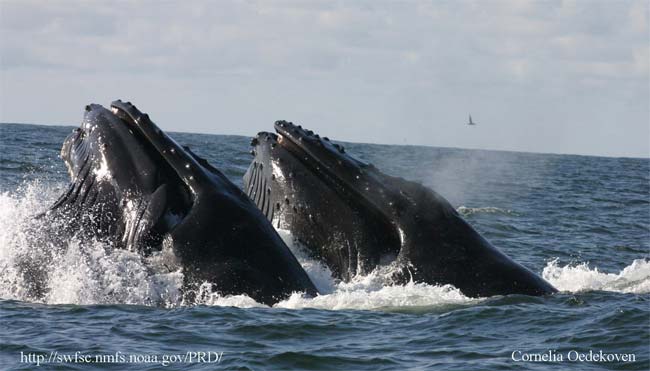Secret of Whale's Open-Mouth Feeding Tactic Revealed

To catch a meal, humpback whales dive at high speeds with mouths open to engulf large volumes of water filled with prey. Now scientists have detected the unique bone adaptations that allow the whales to do this without being injured by the torrents of water and pressure they face.
The study involved rorqual whales, a family of species that includes humpback whales and blue whales – the largest animals on Earth. These creatures feed on small fish and shrimp-like krill by sucking in water during dives deep into the ocean – a practice called lunge feeding.
The whales have a special stretchy tissue attached to their jaws called ventral groove blubber. When they lower their jaws to extreme angles and swim very quickly, a drag force on this blubber causes it to expand to encompass a volume that can be bigger than the whale itself. This enables rorqual whales to capture enough food in a few hours to sustain them for the rest of the day.
Yet this feeding takes a toll. The extreme force of the inrushing water pulls on the blubber, which exerts an extremely strong drag on a whale's lower jaw – called a mandible. Scientists have been unsure how the mandible can actually withstand such force.
"We were interested in finding out whether the mandibles exhibit a specialized mechanical design that would enable to them to not break during the stresses," said zoology student Daniel J. Field of the University of British Columbia in Vancouver, Canada. "The fact that they can withstand such gigantic forces is truly remarkable."
For his undergraduate thesis, Field worked with his supervisor Robert Shadwick and fellow researchers to measure the mandible bones of humpback whales. The team used a process of X-ray scanning called quantitative computed tomography (QCT) to calculate the jaw bones' three-dimensional geometry and density distribution.
The scientists discovered that humpback whale mandibles are shaped in a unique way, different from the mandibles of humans and right whales – the only other species for which QCT data is available.
Sign up for the Live Science daily newsletter now
Get the world’s most fascinating discoveries delivered straight to your inbox.
In particular, the scientists measured a feature called flexural rigidity – a combination of high bone density and large cross-sectional area that allows a bone to resist bending. The researchers found that humpback whales' jaws are formed with a unique pattern of flexural rigidity – highest at the edges attached to the skull, and lowest at the center – that is optimized to resist the strain from lunge feeding.
"Just by having a look at the data it's really surprising how beautifully adapted the whales' mandibles are to withstand the forces it's exposed to on a daily basis," Field told LiveScience. "It was surprising and quite interesting to discover."
The researchers published their findings in the July 2010 issue of the journal The Anatomical Record: Advances in Integrative Anatomy and Evolutionary Biology.
- 10 Amazing Things You Didn't Know about Animals
- Dangers in the Deep: 10 Scariest Sea Creatures
- Gallery: World's Biggest Beasts











